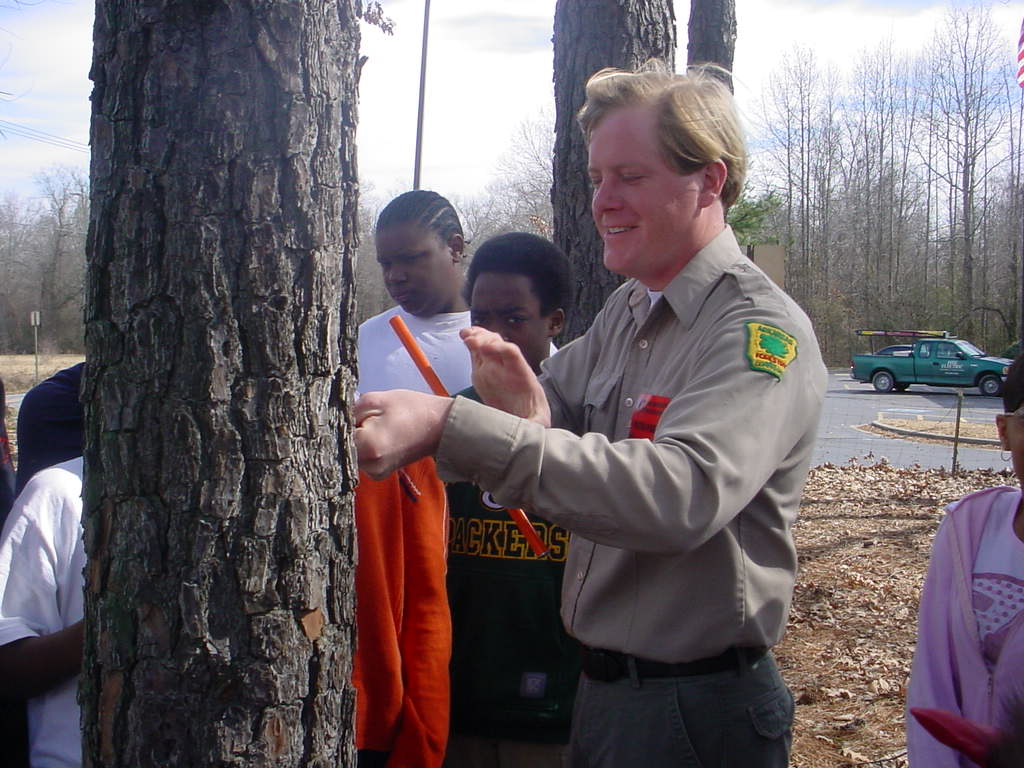When I considered submitting an article to The Branch, my concern was not what to include, but how I would limit the description of what I do to fit the limited space. As an Environmental Science teacher, I use numerous PLT activities throughout the year that encourage students to get outdoors. The unit that most vividly depicts my success in getting students outside is dendrochronology. For more ideas on how PLT can help you take your students outside, visit www.learnoutside.org.
What is dendrochronology? Simply put, dendrochronology is tree ring dating. It is also used as a record of climate changes and events in human history within a region.
During this unit, students are introduced to tree cookies using the following activities in PLT’s Pre K-8 Environmental Education Activity Guide:
Activity 76 – “Tree Cookies” I invite an Arkansas Forestry Commission forester to give a classroom demonstration on how to read the clues left behind while a tree was alive. The students then go outside and participate in aging a living tree with an increment borer. They study the growth rings to determine the area’s climate conditions and whether the tree suffered any harsh environmental conditions such as pest infestations, vandalism, or major climate changes. Students can then create their own, personal tree cookies in a variety of different ways. A fun way to do so outdoors involves using sidewalk chalk to draw a large tree cookie on a section of pavement. Students can then share their life experiences with others using their concrete cookie as an illustration.
I invite an Arkansas Forestry Commission forester to give a classroom demonstration on how to read the clues left behind while a tree was alive. The students then go outside and participate in aging a living tree with an increment borer. They study the growth rings to determine the area’s climate conditions and whether the tree suffered any harsh environmental conditions such as pest infestations, vandalism, or major climate changes. Students can then create their own, personal tree cookies in a variety of different ways. A fun way to do so outdoors involves using sidewalk chalk to draw a large tree cookie on a section of pavement. Students can then share their life experiences with others using their concrete cookie as an illustration.
Activity 77 – “Trees in Trouble”
Students learn about detecting how trees become weak, grow unhealthy, and suffer injuries. This can be caused by a number of events, including insect infestation and fire. Arkansas’s Ozark region recently experienced a high rate of oak mortality, caused by the Red Oak Borer. Students see examples of how this insect attacks the tree and damages it. They then inspect the trees on the school campus for signs of insect damage. Several infected tree logs are also observed for insect trails.
Activity 5 – “Poet-Tree”
After learning the signs of injury or infestation, students find their own “special tree” and compose a poem. We compile the poems into a classroom book and leave it for others to enjoy.
As a supplemental resource to PLT’s dendrochronology activities, students can use their new knowledge gained to participate in the USGS activity “Logs of Straw: Dendrochronology.” It can be found online at: https://interactive2.usgs.gov/learningweb/teachers/globalchange_time_lesson.htm. The activity suggests using straws for core samples, but I have found that cutting out paper sample cores and laminating them works much better. This USGS activity mimics PLT’s Activity 76 – “Tree Cookies” as it allows students to use tree rings as a timeline as they correlate the life of a tree with different events in history.
Although the USGS activity is done inside, students become interested in tree growth and want to bore and read trees. They bring in small tree cookies from their home fire logs and share information they have learned. It is energizing to see students interested and excited about their surroundings.
This two-week unit ends with five students participating as activity leaders at a Forest Awareness Day, held at a nearby state park. The Arkansas Forestry Association Education Foundation sponsors these events for fifth graders throughout the state. The five students share what they have learned by leading groups in PLT’s Activity 27 – “Every Tree for Itself”. My students instruct the younger children how to read tree cookies for ageing.
One of my goals as an educator is to teach an understanding of and respect for the Earth’s resources, while sharing my love of nature and the outdoors. Whether it is learning about plants and wildlife, developing a nature trail, or enjoying nature’s aesthetic beauty, PLT has provided me the tools to accomplish these goals. And when my students are able, in turn, to share this understanding and respect with others, the reward grows exponentially.
Heidi Campbell teaches science and Arkansas history to sixth, seventh, and eighth grade students at Mabelvale Magnet Middle School in Little Rock, Arkansas. She was named a Project Learning Tree National Outstanding Educator in 2006.


